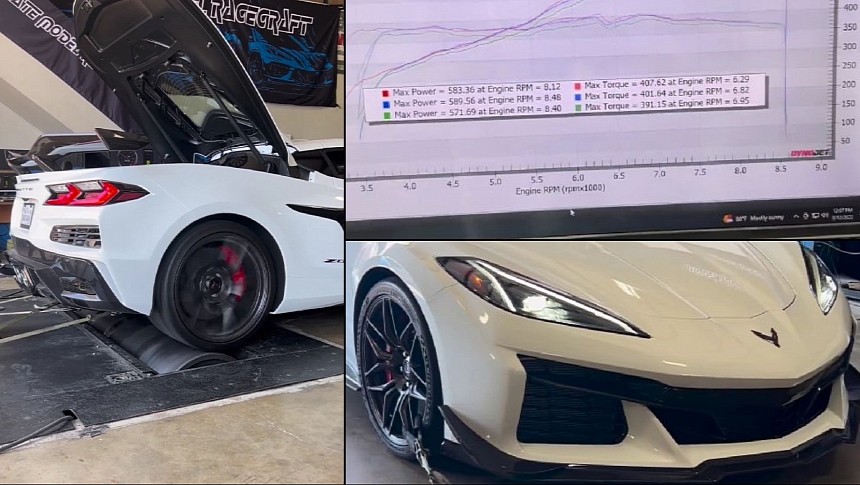The catalytic converter became mainstream for the 1975 model year due to the 1970 Clean Air Act. Believe it or not, Honda circumvented this requirement by developing a stratified charge technology known as CVCC. Think of it as the 1970s equivalent to the pre-chamber ignition system of the Nettuno twin-turbo V6 of the Maserati MC20.
The problem with cats, including modern-day catalytic converters, is that restricting exhaust gas flow hinders engine performance. What's more, cats have an effect on the motor's aural character.
Both performance and sound are why the aftermarket is much obliged to sell you less restrictive catalytic converters. The 2023 model year Corvette Z06 in the video below sports a pair of them, and – not surprising anyone – its high-revving V8 sounds like a riot. Houston-based Late Model Racecraft says that high-flow cats made the Z06 sound like an F1 car, although that couldn't be further from an F1 car.
Even during the V8 era, Formula 1 cars sounded unlike any other V8-engined production vehicle. Said era ran between 2006 and 2013, and the mandated 2.4-liter V8s are capable of spinning beyond 20,000 revolutions per minute. The limit was reduced to 19,000 in '07, then to 18,000 for the '09 season.
Have a wild guess how many revs the flat-plane crankshaft V8 of the C8-gen Z06 can take before the engine control unit cuts off the fuel? That would be 8,600 revolutions per minute, which is mighty impressive for the first 'Vette to feature such an engine. On the other hand, remember that GM took inspiration from the F136 F engine in the Ferrari 458 Italia, which is much obliged to hit 9,000 rpm.
The white-painted Z06 in the featured clip lays down up to 589.56 horsepower at 8,480 revolutions per minute and 407.62 pound-feet (552.65 Nm) of torque at 6,290 revolutions per minute. Compared to the stock crankshaft numbers (670 horsepower at 8,400 and 460 pound-feet/624 Nm at 6,300), that's mighty impressive for nothing more than sports cats.
Late Model Racecraft doesn't list any C8-specific catalytic converters on its website, although we do have a good idea about how much these babies cost. For example, Fabspeed Motorsport charges $4,995 for a pair of 200-cell sports cats designed for the Z06. The Fabspeed Motorsport catalytic converters promise rear-wheel gains of 26 ponies and 28 pound-feet (38 Nm) while dropping 9 pounds (4.1 kilograms) off the stock catalytic converters. Not bad, huh?
Not long now, GM themselves will treat the C8 to more power and torque by means of turbocharging. Expected to drop in 2024 for the 2025 model year, the ZR1 is a twin-turbo affair with a flat-plane crankshaft V8. Its engine is referred to as the LT7, hence its close relation to the Z06-specific LT6.
800 horsepower is a conservative estimate, and GM won't stop there. The final member of the C8 family is dubbed Zora, a hybrid-assisted Corvette that's believed to combine the ZR1's LT7 with the front-mounted electric motor of the Corvette E-Ray for a total system output of approximately 1k ponies.
Both performance and sound are why the aftermarket is much obliged to sell you less restrictive catalytic converters. The 2023 model year Corvette Z06 in the video below sports a pair of them, and – not surprising anyone – its high-revving V8 sounds like a riot. Houston-based Late Model Racecraft says that high-flow cats made the Z06 sound like an F1 car, although that couldn't be further from an F1 car.
Even during the V8 era, Formula 1 cars sounded unlike any other V8-engined production vehicle. Said era ran between 2006 and 2013, and the mandated 2.4-liter V8s are capable of spinning beyond 20,000 revolutions per minute. The limit was reduced to 19,000 in '07, then to 18,000 for the '09 season.
Have a wild guess how many revs the flat-plane crankshaft V8 of the C8-gen Z06 can take before the engine control unit cuts off the fuel? That would be 8,600 revolutions per minute, which is mighty impressive for the first 'Vette to feature such an engine. On the other hand, remember that GM took inspiration from the F136 F engine in the Ferrari 458 Italia, which is much obliged to hit 9,000 rpm.
The white-painted Z06 in the featured clip lays down up to 589.56 horsepower at 8,480 revolutions per minute and 407.62 pound-feet (552.65 Nm) of torque at 6,290 revolutions per minute. Compared to the stock crankshaft numbers (670 horsepower at 8,400 and 460 pound-feet/624 Nm at 6,300), that's mighty impressive for nothing more than sports cats.
Late Model Racecraft doesn't list any C8-specific catalytic converters on its website, although we do have a good idea about how much these babies cost. For example, Fabspeed Motorsport charges $4,995 for a pair of 200-cell sports cats designed for the Z06. The Fabspeed Motorsport catalytic converters promise rear-wheel gains of 26 ponies and 28 pound-feet (38 Nm) while dropping 9 pounds (4.1 kilograms) off the stock catalytic converters. Not bad, huh?
Not long now, GM themselves will treat the C8 to more power and torque by means of turbocharging. Expected to drop in 2024 for the 2025 model year, the ZR1 is a twin-turbo affair with a flat-plane crankshaft V8. Its engine is referred to as the LT7, hence its close relation to the Z06-specific LT6.
800 horsepower is a conservative estimate, and GM won't stop there. The final member of the C8 family is dubbed Zora, a hybrid-assisted Corvette that's believed to combine the ZR1's LT7 with the front-mounted electric motor of the Corvette E-Ray for a total system output of approximately 1k ponies.







